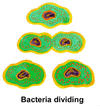|
Populate or perish
One characteristic of living things is that they can reproduce to create
new organisms similar to themselves and thereby continue as a species
through time even though individuals die. Without the ability to reproduce,
the species would become extinct.
Asexual reproduction
 Some simple organisms like bacteria can reproduce
asexually. This involves the growth of the cell, duplication of the
nucleus (see Animal cells) and then division into two new cells. Some
changes (mutations) can occur to the genetic information during nuclear
division, but generally the new individuals are the same as the "parent".
Some simple organisms like bacteria can reproduce
asexually. This involves the growth of the cell, duplication of the
nucleus (see Animal cells) and then division into two new cells. Some
changes (mutations) can occur to the genetic information during nuclear
division, but generally the new individuals are the same as the "parent".
 Growing plants from runners or cuttings is a form of asexual reproduction
as only one "parent" is involved, and no gametes are produced.
The "offspring" are the same as the parent.
Growing plants from runners or cuttings is a form of asexual reproduction
as only one "parent" is involved, and no gametes are produced.
The "offspring" are the same as the parent.
Similarly, cloning uses genetic information from only one parent,
so the offspring will be identical to that parent.
Sexual reproduction
 Most organisms reproduce sexually. This always involves the fusion
of two different types of gametes (eggs and sperm).
Most organisms reproduce sexually. This always involves the fusion
of two different types of gametes (eggs and sperm).
The offspring therefore carry a mixture of characteristics from both
parents (see Inheritance).
This increases biodiversity, or the number of different types in a population,
some of which may survive better. If an individual survives better,
it has a better chance of reaching reproductive maturity and having
more offspring which will also inherit this advantageous feature (see
Species and Evolution).
Number of young
Humans generally only have one or two babies at a time. This reflects
the amount of care needed before the child is capable of surviving alone.
Fish, however, produce thousands of eggs and babies, but the chance
of any one of these surviving is very low. Without parental protection,
they are likely to be eaten by predators, hence large numbers of young
are required to ensure enough survive to reproduce.
Reproductive rate
Many animals like kangaroos and rabbits will not reproduce if the environmental
conditions are poor, such as when there is no food due to drought. This
reduction in reproduction obviously helps the survival chance of the
young.
Endangered?
If the life cycle is interrupted so that the birth rate falls below
the death rate, then the population numbers will drop. This could be
caused by reduction in nesting sites due to logging, reduced food, disease,
increased predator numbers, or poor environmental conditions. The following
terms reflect the degrees of population decline.
- Vulnerable: Population likely to decline
if environmental conditions change unfavourably.
- Threatened: Population likely to continue
to decline due to altered environmental conditions.
- Endangered: Numbers in nature
considered too low to avoid extinction without Man's intervention
through conservation management, for example, tiger quoll, helmeted
honeyeater, giant panda.
- Extinct: No known individuals
still alive of a species once present on Earth, e.g. thylacine,
dinosaurs (see Too
late: Extinctions).
|
|
|